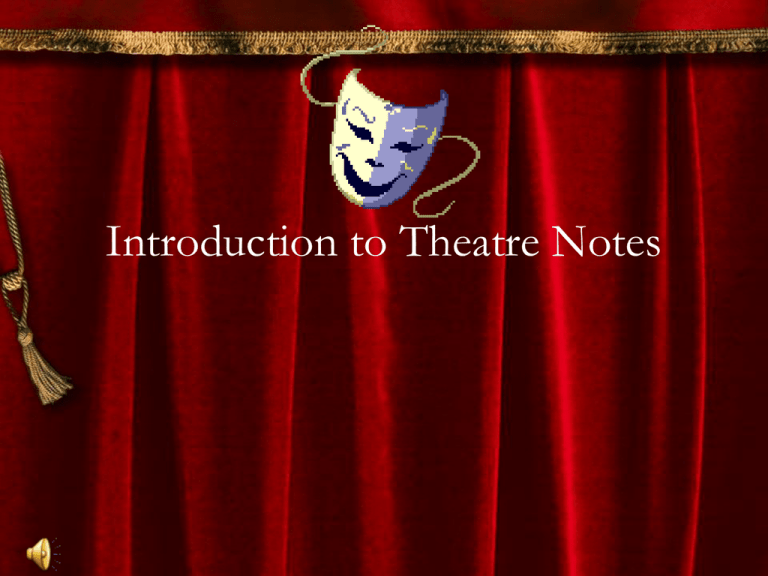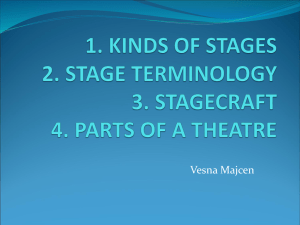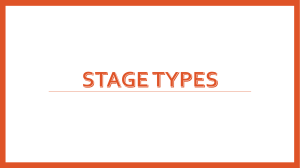Introduction to Theatre: Notes on Etiquette & Stage Positions
advertisement

Introduction to Theatre Notes Similarities and Differences in Television, Theatre, and Film Television Film Theatre Prerecorded and edited Prerecorded and edited Viewed Live Intimate Medium Large Casts Both Viewed in small and often private settings Large screen suited for mass audiences and spectacle Actual presence of actors helps establish unique audience/ player relationship Television Film Theatre Has capacity to deal with events as they happen N/A N/A Requires least audience commitment Requires some audience commitment Requires the most audience commitment Mobile cameras enable the settings to be realistic and in great detail Mobile cameras enable the settings to be realistic and in great detail Settings limited and audience’s sightlines must be considered Television Film Theatre Can be filmed on location Can be filmed on location N/A Actual lighting, weather, and environmental conditions can be recorded Actual lighting, weather, and environmental conditions can be recorded Lighting must approximate time and conditions “Flashbacks” can be shown immediately “Flashbacks” can be shown immediately “Flashbacks” are harder to convey Television Film Theatre Illusions and the passage of time are easier to convey because the camera can start and stop Illusions and the passage N/A of time are easier to convey because the camera can start and stop Special effects can appear realistic Special effects can appear realistic Special effects are limited Computer graphics can be used to create illusions Computer graphics can be used to create illusions N/A Television Film Theatre The slightest movement, gesture, or sound is easily recorded by the camera The slightest movement, Voice and gestures may gesture, or sound is be exaggerated easily recorded by the camera Use of canned laughter stimulates the audience Use of canned laughter stimulates the audience N/A THEATRE ETIQUETTE A professional performer will… • Be on time for EVERYTHING! • Never miss a cue! • Be quiet backstage, have courtesy for other performers. • Listen to his/her director, follow directions. • Always be courteous to technicians. • Always take care of his/her costumes and make-up. • Clean the make-up room, even if he/she didn’t mess it up. • Leave personal problems at the door. • Remember personal hygiene. • Only use constructive criticism. • Bring something new to each rehearsal and expand his/her range. • Encourage others. • Have lines memorized before deadline. • Pay attention to rehearsal—even when not onstage. • Never over estimate his/her own greatness. • Always be prepared, mentally and physically, for rehearsals and performances. • Never pick up a prop that he/she does not use. • Never chew gum on stage. • Absolutely, never eat or drink in costume. • Never take food or drink in the dressing rooms. • Set a positive example for others. • Not be seen in costume before the show. • Be prepared for auditions—find out what is expected beforehand! • Be helpful at auditions—especially to young performers. • ** Always leave everything you touch or do better than it was before you came!!! • **Love the art in yourself—not yourself in the art!! A courteous audience member will… • Be early for curtain. • If late, be discrete and sit in the back, quietly. • Be courteous to those around you, they paid too! • Applaud at appropriate times. • Never, yell names during a performance. • Follow the theatre facility rules. • Congratulate the performers afterward—they will appreciate it. • Not use flash photography. • Not talk during performance. • Never put his/her feet on the back of the chairs. • Never leave a performance during the show. • Remove his/her hat inside the theatre. • Keep his/her comments constructive—be tactful. • **Learn from each performance. The Performance Space Types of Stages • Proscenium Stage: Like a picture frame. The audience sits on one side to watch the action through the frame (also known as the fourth wall). Often, curtains hide the scenery until the play begins. Continued… • Arena or In-the-round Stage: The audience sits all around it. The actors enter and exit from the aisles or sometimes from tunnels under the audience. Continued… • Thrust Stage: A combination of the arena and proscenium stages. The audience sits on two or three sides of the acting area, which projects, or thrusts, into the audience area from a rear wall, which has some kind of scenery. The actors enter and exit through the audience as in an arena stage and also through doors in the rear-wall scenery as in a proscenium stage. Theatre Layout Terms • • • The Lobby: The area where the audience gathers before, during intermission, and after performances. Restrooms, concession stands, and the ticket booth/box office are located in the lobby. The House: The area where the audience sits. Light and Sound Booth: Where the lighting and sound control boards are located. Located above the audience in the rear of the house. Continued… • • • The Stage House: The area including the stage and the fly space above (where scenery and lights are suspended on ropes or “flown”). Proscenium Arch: The picture frame through which the scenery and action are viewed. Grand drape: The front curtain, which is typically made of luxurious fabric in deep colors. Continued… • • • Apron: An acting area than extends forward beyond the arch on a proscenium stage. Back wall: Separates the stage house from the backstage area. Backstage: All areas other than the stage, house, and lobby in a theatre. The dressing rooms, make up rooms, and green room are backstage. Continued… • • Green Room: A lounge area in which actors may wait while not onstage or greet audience members after the performance. Call Board: A bulletin board where rehearsal times, performance changes, and special notices are posted. Stage and Body Positions STAGE POSITIONS ARE FROM THE ACTOR’S POINT OF VIEW!!! THE AUDIENCE THE STAGE IS DIVIDED INTO THREE AREAS ACROSS. THE AUDIENCE THE STAGE IS DIVIDED INTO THREE AREAS FROM FRONT TO BACK. UPSTAGE IS AWAY FROM THE AUDIENCE AND DOWNSTAGE IS TOWARD THE AUDIENCE. “THE ACTOR COMES DOWN TO THE AUDIENCE.” THE AUDIENCE THE ACTING AREA BECOMES A GRID OF 9 AREAS. Up Right Right Center Down Right Up Center Center Down Center THE AUDIENCE Up Left Left Center Down Left So why is down stage down and up stage up??? In the Renaissance, stages were RAKED. They actually sloped down toward the audience to allow audience members to see the action. Actor’s Body Positions Full Back ¾ Left ¾ Right Profile Right Profile Left ¼ Right ¼ Left Full Front



